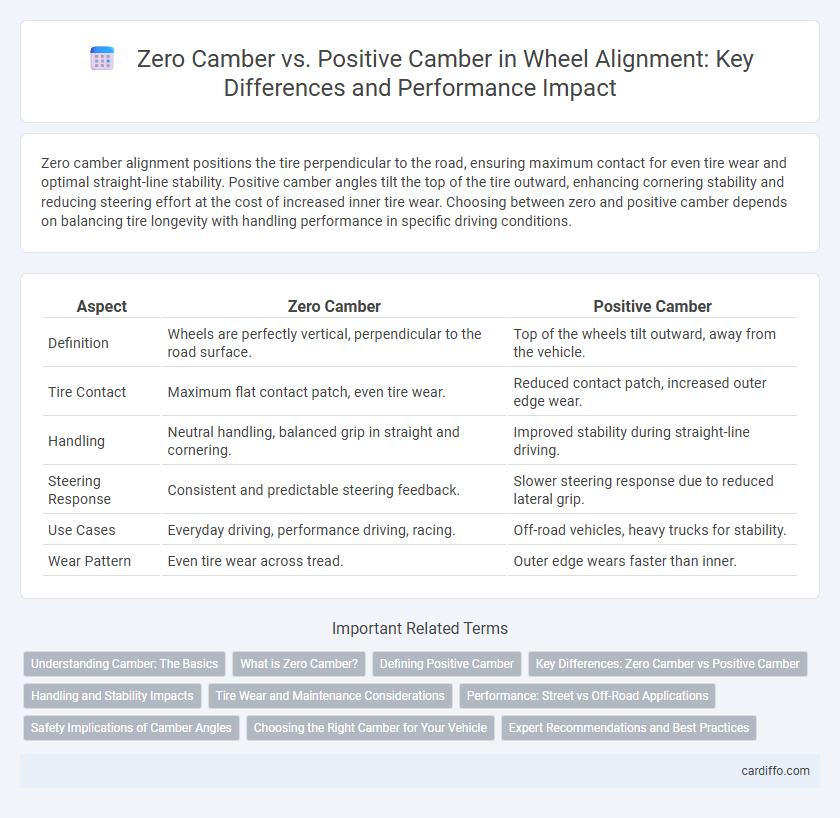Zero camber alignment positions the tire perpendicular to the road, ensuring maximum contact for even tire wear and optimal straight-line stability. Positive camber angles tilt the top of the tire outward, enhancing cornering stability and reducing steering effort at the cost of increased inner tire wear. Choosing between zero and positive camber depends on balancing tire longevity with handling performance in specific driving conditions.
Table of Comparison
| Aspect | Zero Camber | Positive Camber |
|---|---|---|
| Definition | Wheels are perfectly vertical, perpendicular to the road surface. | Top of the wheels tilt outward, away from the vehicle. |
| Tire Contact | Maximum flat contact patch, even tire wear. | Reduced contact patch, increased outer edge wear. |
| Handling | Neutral handling, balanced grip in straight and cornering. | Improved stability during straight-line driving. |
| Steering Response | Consistent and predictable steering feedback. | Slower steering response due to reduced lateral grip. |
| Use Cases | Everyday driving, performance driving, racing. | Off-road vehicles, heavy trucks for stability. |
| Wear Pattern | Even tire wear across tread. | Outer edge wears faster than inner. |
Understanding Camber: The Basics
Zero camber refers to the wheel being perfectly vertical to the ground, optimizing tire contact for even wear and straight-line stability. Positive camber means the top of the wheels tilt outward, which enhances cornering stability but may reduce traction during acceleration. Understanding the effects of zero versus positive camber is crucial for balancing tire performance, vehicle handling, and suspension setup.
What is Zero Camber?
Zero camber refers to a wheel alignment setting where the wheels are perfectly vertical, meaning the top and bottom of the tire are parallel to the vehicle's centerline. This alignment optimizes tire contact with the road surface, promoting even tire wear and stable handling under normal driving conditions. Zero camber is commonly used for everyday vehicles prioritizing balanced performance and tire longevity.
Defining Positive Camber
Positive camber occurs when the top of the wheels tilt outward relative to the vehicle's centerline, enhancing stability during straight-line driving by increasing the tire's contact patch. This alignment angle is often used in off-road and agricultural vehicles to improve cornering performance on uneven surfaces. Compared to zero camber, which aligns the wheels perfectly vertical, positive camber reduces inner tire wear and accommodates heavy loads more effectively.
Key Differences: Zero Camber vs Positive Camber
Zero camber features wheels aligned vertically perpendicular to the road, promoting even tire wear and balanced contact patches ideal for everyday driving. Positive camber angles wheels outward at the top, enhancing stability and steering responsiveness in off-road or heavy-load conditions but may accelerate inner tire wear. Understanding these distinctions is essential for optimizing vehicle performance, handling, and tire lifespan according to driving needs.
Handling and Stability Impacts
Zero camber offers balanced tire contact with the road, optimizing straight-line stability and promoting even tire wear for predictable handling. Positive camber tilts the top of the wheels outward, reducing cornering grip but enhancing stability during straight-line driving by minimizing steering effort. Choosing between zero and positive camber depends on desired handling characteristics, as zero camber favors agility while positive camber improves stability under high-speed conditions.
Tire Wear and Maintenance Considerations
Zero camber ensures even tire contact with the road, minimizing uneven tire wear and extending tire life, making maintenance less frequent and less costly. Positive camber leads to increased wear on the outer edges of tires due to reduced contact area during cornering, resulting in more frequent tire replacements and alignment checks. Proper camber adjustment based on driving conditions and vehicle type optimizes tire performance and reduces overall maintenance expenses.
Performance: Street vs Off-Road Applications
Zero camber provides balanced tire contact with the road, optimizing tire wear and stability for street driving. Positive camber enhances off-road traction by increasing the tire's outer edge contact during aggressive maneuvers and uneven terrain. Off-road vehicles benefit from positive camber for improved cornering grip and obstacle traversal, while street cars maintain zero camber for consistent handling and tire longevity.
Safety Implications of Camber Angles
Zero camber alignment ensures maximum tire contact with the road, enhancing vehicle stability and reducing uneven tire wear, which directly contributes to safer handling under normal driving conditions. Positive camber angles, where the top of the tire tilts outward, decrease grip during cornering but can improve straight-line stability on certain heavy vehicles, though they may increase the risk of tire slippage under aggressive maneuvers. Choosing the appropriate camber angle is critical for optimizing tire performance, preventing premature wear, and maintaining safe traction, especially in emergency situations or adverse weather conditions.
Choosing the Right Camber for Your Vehicle
Selecting the right camber angle, whether zero camber or positive camber, significantly impacts vehicle alignment and tire performance. Zero camber offers even tire wear and optimal straight-line stability, ideal for daily driving and fuel efficiency. Positive camber enhances cornering grip and steering response, making it suitable for off-road vehicles and heavy-duty trucks requiring improved lateral control.
Expert Recommendations and Best Practices
Experts recommend zero camber for achieving balanced tire wear and improved straight-line stability in daily driving and street applications. Positive camber is best suited for specific conditions requiring enhanced cornering grip on loose or uneven surfaces, such as off-road or rally applications. Optimal alignment settings depend on vehicle type, driving style, and road conditions, with professional alignment shops using precise measurements to tailor camber angles accordingly.
Zero Camber vs Positive Camber Infographic

 cardiffo.com
cardiffo.com